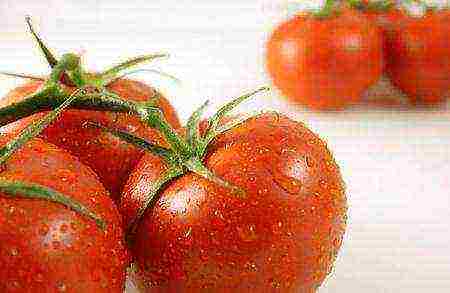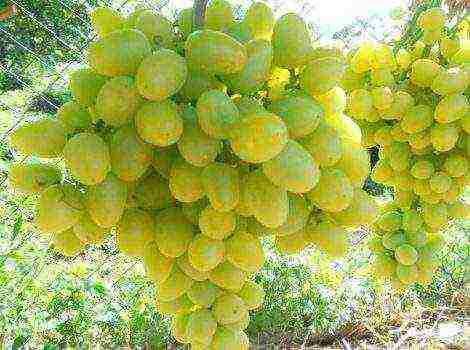Content [show]
Read: 3 037
Popular varieties of carrots
Which variety of carrots to choose for sowing? Many gardeners ask themselves this question. First of all, when choosing varieties you need to decide for what purposes you will grow carrot.
Early ripe carrot varieties As a rule, they are used for fresh consumption and for harvesting in the winter. But for storage they are suitable mid-season, mid-late and late varieties of carrots.
Having decided on the purpose, you need to choose a variety. Most often, experienced gardeners plant proven varieties and hybrids of carrots.
In our review, we tried to select varieties based on personal experience and comments from gardeners and gardeners, which were analyzed on various forums and sites. Of the wide variety, the most popular varieties of carrotswho enjoy good reviews.
I want to attract your attention! Carrot seeds in granules should be sown in the spring, while the soil is still abundantly saturated with melt water. Delayed sowing can result in poor seed germination. the granules simply do not have time to dissolve in insufficiently moist soil. (Tested on personal experience. That year we were left without carrots!)
Ripening period of carrot root crops - it is considered to be from the emergence of mass shoots to the technical ripeness of root crops.
- Early ripening (early ripening) varieties - the period of ripening of root crops is 60-100 days.
- Mid-season varieties - ripening period 100-120 days.
- Late-ripening varieties - ripening period 120-150 days.
Early ripe carrot varieties
Carrot variety Canning
Variety "Artek» - an early ripe variety of carrots. The shape of the root crop is cylindrical with a weak slope to the base and a thickened tip. The length of the root crop is 15-17 cm, diameter is 3-4 cm, weight is 80 - 130 g. The surface of the root crop is smooth with faint eyes. The root crop is completely immersed in the soil during growth, which prevents the fruit from turning green in the light. The fruit has a pith, which is 35-40% of the diameter of the root, with orange flesh. The sugar content is 6-7%. Carotene –13 mg% carotene.
Variety "Canned" is an early ripening variety of carrots. A large thickened root vegetable with a smooth surface and weakly pronounced eyes, dark orange, conical in shape with a weak run to the base and a thickened tip. The length of the root crop is 14-16 cm, the diameter is 4-4.5 cm, the weight is 80-150 g. The root crop is completely submerged in the soil. The core is 40-45% of the root crop diameter. Solids content 12-14%, sugars 5-8%, carotene 9-14 mg%. Keeping quality of root crops is good.
Variety "Nandrin F1 "is a popular early ripe hybrid carrot variety. Root crops ripen 75-80 days. Root crops are long, smooth, conical in shape, aligned in shape, 16-20 cm long. The color of the root crops is orange-red, weighing 100-120 g, excellent taste. Differs in resistance to cracking during uneven watering. The variety is recommended for fresh consumption, processing and long-term storage.
Carrot variety Nandrin F1
Variety "Napoli F1 "- early ripening hybrid carrot variety. Root crops 16-20 cm long, weighing 65-150 g.Root is completely submerged in the soil and plant trees and gardens. Characterized in that the thickening can be grown at landings and appreciated for friendly yield and resistance to mechanical damage.
Grade "Baltimore F1 "- early maturing hybrid carrot productive... Superior analogue hybrid "Nandrin F1 ». Root crops are large, juicy, intense color. Excellent for the preparation of juices and salads. Plant strong, dark green color is resistant to hybrid and bacterial diseases.
The variety "Nellie F1 "- early maturing hybrid carrot variety. the ripening period is 80-85 days. A root crop of a beautiful orange color, cylindrical in shape, smooth, aligned in shape, of excellent taste. Length 18 cm, diameter 3 cm, weight 80-110 g Recommended for fresh consumption.
Grade carrots sautéed Savoy
Grade "Lydia F1 "- middle-early hybrid variety carrots. Term of maturing 85-90 days. Root conical-cylindrical shape. Over 27 cm in length, 2.5 cm in diameter, weighing 90-100 g Surface Root crop smooth, beautiful bright orange color. The head of root crops are not small greens. The core is very small. Root crops of high taste. The variety is resistant to tsvetushnosti. It recommended for growing high beds. It cultivated in moderate and southern regions. It is used for fresh market, processing and canning of whole roots. Grade average yield.
Grade "Krasavka" - an early variety of carrot. One of the best varieties of carrots in taste. Term of maturing 60-90 days. Root orange-red color, a cylindrical shape with a blunt end and a length of 17-20 cm, weighing 130-200 g small thin core. The surface is smooth with a slightly prominent eyes. The pulp is intensely orange, juicy, sweet. The variety is recommended for fresh consumption, processing, baby food and dietary.
Grade carrots Chocolate Bunny
Grade "sautéed Savoy" - a popular early varieties of carrots. Ripening time of 80-100 days. The variety is recommended for spring planting. Root cylindrical bright orange color, with a thin core. Root crop length 15-18 cm, weight 100-200 g Pulp root crops sweet, juicy, with a carotene content of 11,6-11,9%. Valued for high yields, high product quality, disease resistance. Recommended for fresh consumption and processing.
Grade "Chocolate Bunny" - early maturing, high-yielding, hybrid variety of carrots. Term of maturing 65-70 days. Root purple color, flesh dark orange, flavorful, crunchy, very sweet. Is rich in carotene, vitamins (C), sugars. Root conical length 15-20 cm. It is an unusual hybrid, because of its color will look beautiful in salads. The seeds have a high germination rate, so you need to sow quite rare (at a distance of 3-4 cm from each other). Recommended for fresh consumption, salads, processing.
middle-grade carrots
Carrot variety Nanskaya 4
The variety "Nantes" - the most popular middle-early variety of carrot. Ripening time of 90-105 days. Root cylindrical shape, with a blunt end, orange-red color, green or purple pigmentation of the head. Weighing 90-150 g, length 16 cm, diameter 4.5 cm. Root excellent mild taste with a small core, the pulp is juicy, tender, sweet. carotene content of 18-20 mg%. Yielding varieties with good keeping quality. Used for fresh consumption, processing and long-term storage. The variety is resistant to tsvetushnosti.
The variety "Nantes" - middle-grade carrots. the ripening period is 90-105 days. Root cylindrical blunt with saturated bright orange color of the external and internal, 16-18 cm long, 5-5.5 cm in diameter, weighing 110-120 g core root small orange. The pulp is tender, juicy, of excellent taste.Recommended for fresh consumption, processing and long-term storage.
Carrot variety Shantane 2461
Variety "Shantane 2461" is a mid-season carrot variety. Ripening period 65-105 days. Root crops are cone-shaped, blunt-pointed, orange in color. The core is large. Weight 80-240 g, length 15 cm, diameter 6 cm. Taste is average. Resistant to blooming and cracking. It is appreciated for its good keeping quality. High-yielding variety. The variety is intended for fresh consumption, processing and winter storage.
Variety "Shantane royal" - mid-season fruitful carrot variety. The period from germination to harvest is 90-110 days. The root crop is leveled, conical, 15-17 cm long, weighing 110-180 g. It is successfully grown in all regions. The color of the root crop is orange-red. Root crops of high taste. Prized for its high carotene content. The variety is recommended for fresh consumption, processing, has good keeping quality. The variety is considered one of the best for juicing, baby and diet food.
Carrot variety Shantane royal
Variety "Vitaminnaya 6" is a mid-season carrot variety. Root crops are cylindrical, blunt-conical, with a smooth surface. Roots outside and inside are orange in color. Root weight 140-160 g, length 14-16 cm, diameter 4.9 cm. Yielding variety with high taste. It is prized for its high content of carotene and sugars. Recommended for making juices, baby and diet food.
The Losinoostrovskaya 13 variety is a mid-season carrot variety. Root crops are cylindrical, slightly tapering towards the base, 16-18 cm long, weighing 150-170 g. The surface of the roots is smooth with small eyes. The pulp and core are orange, juicy. Taste qualities of root crops are high. The carotene content is increased - up to 20%. A productive variety. The variety is recommended for fresh consumption, processing and storage.
Variety "Belgrade F1 "is a new mid-season hybrid carrot variety. Root crops are long-cylindrical, with a slight transition to a cone, shape. Excellent taste - has a sweet taste. The color is bright orange. The tops are powerful, strong and resistant to Alternaria, cercosporosis, and bacterial diseases. The variety is ideal for use in salads, getting early production at an underestimated sowing rate.
Carrot variety Moscow winter A 515
Variety "Niioh 336" - mid-season carrot variety... Ripening period 98-113 days. Root crops are orange, cylindrical, blunt-pointed. Root weight 130g. High-yielding variety. It is appreciated for its high carotene content - up to 23% and good keeping quality. The variety is one of the best for juicing, baby and diet food.
Variety "Moscow winter A 515" is a mid-season carrot variety. Ripening period 70-105 days. Can be sown before winter. Suitable for planting in various regions. Root crops are conical blunt-pointed. Length 20 cm, diameter 5 cm. The color of the root crop is orange, weighing 100-180 g. Root crops of excellent taste. Possesses resistance to flowering. Differs in good keeping quality. Recommended for fresh consumption and winter storage.
Variety "Delicacy" is a mid-season carrot variety. Root crops are cylindrical, very long, weighing 85-16 g. Outside and inside are red. It is appreciated for its excellent taste, high yield, good keeping quality, high content of carotene and vitamins.
Carrot variety Emperor
The "Emperor" variety is a mid-season carrot variety. A variety of foreign selection. Root crops are large, truncated cylindrical in shape, with a blunt tip, weighing 100-160 g. The fruit is bright orange in color, with a small core and juicy, crispy, dense pulp. It is appreciated for its stable yield, good taste and good keeping quality. Recommended for fresh consumption and winter storage. Resistant to blooming and cracking.
The "Incomparable" variety is a mid-season fruitful carrot variety. Ripening period 90-115 days Cylindrical roots with a blunt tip, 18-20 cm long, weighing 90-200 g. The color of the roots is red-orange, the pulp is bright orange, sweet, juicy, tender. The core is tightly connected to the pulp. Resistant to bloom and disease. Cold-resistant variety, suitable for winter sowing. The variety is valued for the excellent keeping quality of root crops, suitable for storage in the winter. Good taste, high carotene content.
Variety "Samson" is a mid-season, high-yielding variety of carrots. A very popular variety. Ripening period 110-115 days. Root crops are cylindrical, smooth, rounded, with a blunt tip, aligned in size. There is little or no core. The length of the roots is 20-22 cm, the weight is about 180 g. The color of the roots is bright orange. The pulp is juicy, tender, sweet. The tops are strong, rich green. Root crops are characterized by a high content of carotene and vitamins. Disease resistance is high. The variety is unpretentious - suitable for growing on any soil in adverse climatic conditions. A variety of universal use - used fresh, for processing and long-term storage. The variety is valued for its high yield, friendly shoots, good taste, excellent keeping quality.
Mid-late and late-ripening carrot varieties
Carrot variety Canada F1
The Gulchatay variety is a mid-late variety of carrots. Ripening period 115-125 days. Root crops are cylindrical, blunt-pointed, 16-18 cm long, 3-4 cm in diameter. The flesh of the roots is yellow, juicy, sweet, tender. Root vegetables with a small rounded core. The color of the root crop on the surface is orange. It is appreciated for its excellent taste. Suitable for long-term storage, processing and fresh consumption.
Variety "Canada F1 "- medium late unpretentious hybrid carrot variety. Ripening period 120-130 days. Root crops are cone-shaped, aligned with a rounded tip, 18-20 cm long, 4-5 cm in diameter, weighing 130-170 g. The color of the whole fruit is bright orange. The core is small. Root vegetables with a high content of beta-carotene. The hybrid is resistant to diseases, especially resistant to flowering. It is appreciated for its high yield on heavy soils in unfavorable natural conditions. The taste is excellent.
Berlicum royal carrot variety
Berlikum Royal is a late-ripening carrot variety. Ripening period 110-130 days. Large root crop with a smooth surface, cylindrical blunt-pointed shape. Root length 22 cm, weight 120-190 g. Easily removed from the ground during harvesting. The root vegetable is orange outside and inside. The taste is high - the roots are sweet, juicy and tasty. The variety is excellent for fresh consumption, processing and long-term storage. It is resistant to fusarium and carrot fly.
The "Queen of Autumn" variety is a popular high-yielding late-ripening carrot variety. Ripening period 120-130 days. Root crops are cylindrical, orange in color, up to 25 cm long, weighing 150-200 g. Taste qualities are excellent - the pulp is juicy and sweet. Designed for long-term winter storage. Also suitable for fresh consumption and for processing. The variety is resistant to shooting and cracking.
Carrot variety Red giant
Variety "Autumn Giant" is a late-ripening high-yielding variety of carrots. Ripening period 110-130 days. The root crop is large, conical in shape, leveled in size, 15 cm long, weighing 150-180 g. Taste quality is high - the roots are juicy, sweet, red-orange in color. A variety of universal use. It is appreciated for its high yield, high commercial quality, and resistance to diseases. Root crops during growth are completely immersed in the soil.
Variety "Red Giant" - a late-ripening variety of carrots. One of the best late-ripening carrot varieties. The variety is recommended for early spring and winter sowing.Root crops are large, their length reaches 25 cm, and their diameter is up to 6 cm, with an average weight of up to 150 g. Fruits are cylindrical in shape with a blunt end. The core is medium in size. Root crops are red-orange in color, the pulp is rich orange, juicy, sweet, with a lot of vitamins. The variety is valued for its high yield, resistance to diseases and pests, excellent keeping quality and preservation of taste and marketability. Suitable for fresh consumption, processing, long-term winter storage.
If in our review you did not find your favorite carrot varieties, you can share your experience. Write short variety description in the comments to the article. We will be very grateful to you!
High yields!
Carrots rotting in the cellar are a problem that many gardeners face. There are many reasons for spoilage of the root crop, this is an infection in the cellar, dampness and high air temperature during storage... But in most cases, flabby carrots in winter are the wrong choice of variety.
The best varieties of carrots for winter storage
 Carrot harvest
Carrot harvest
Every spring summer residents have the question of how, among the abundance of beautiful bags of seeds, to find the best carrots for storage for the winter... Many people choose by the photo on the package, but this is wrong. First, let's get acquainted with the most mature species. Then we will find out by what principle you need to choose a variety that preserves its taste and presentation well in winter.
Mid-season
The mid-ripening group includes fruits with a growing season of 100 - 120 days. According to experts, these roots are sweeter and more juicy.
Mid-season carrots accumulate maximum nutrients by the time of harvest.
Consider the well-known and popular among experienced gardeners:
- Nantes-4.
- Samson.
- Chance.
- Moscow.
Nantes-4
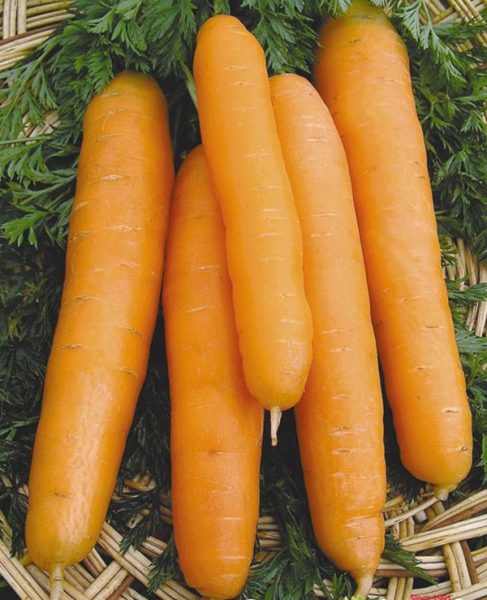 Carrot Nantes-4
Carrot Nantes-4
An old variety that gardeners in Siberia, the Urals, the Moscow region, in general, all regions, without exception, have been growing since the middle of the last century. It takes 120 days to mature... Bunch ripeness occurs after 50 days from germination. Carrots planted in May are ready for harvest in September. If there is not enough time for cleaning, it can be left in the ground until October. Nantes-4 in such a situation does not lose its presentation and taste. Average weight parameters - 150 g. Average length, within 20 cm. Important characteristics: yield from 6 kg per sq.m. and the shelf life is February.
Samson
 Mid-season carrots Samson
Mid-season carrots Samson
Large carrots, which are stored in a cellar until May next year. Experienced agronomists recommend Samson to novice gardeners. It can be grown in any soil, in any climate. With timely sowing in early May, Samson will delight you with even, orange root crops, almost without a core. The average length of the Samson root crop is 20 centimeters or more, weight up to 170 g... Ripens in 110 days from the appearance of the first shoots.
Chance
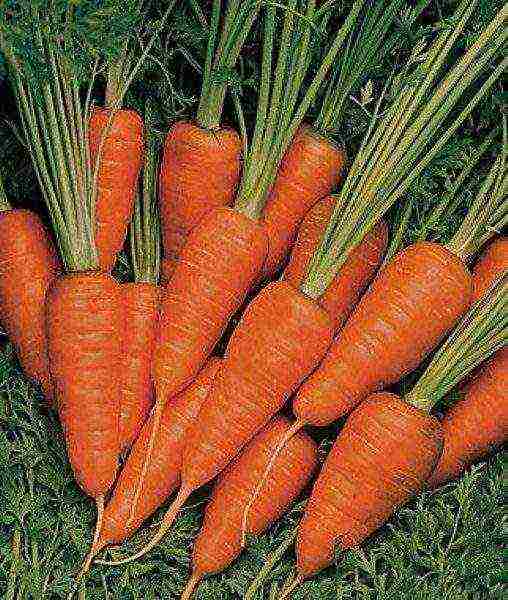 Carrot variety Chance
Carrot variety Chance
Stored until March. Root crops weighing up to 130 g have a good taste, are juicy, and have a classic conical shape. Subject to the sowing scheme recommended by the manufacturer (20 * 4 cm), the yield from 1 sq. m - 5 kg... Chance carrots love the sun, loose soil with a high percentage of humus (sandy loam, light loamy.).
Late, suitable for storage
Vegetable varieties with a growing season of more than 120 days are classified as late... Ripe carrots can be stored until the next harvest. This group of plants suffers less from diseases, carrot flies, rarely shoots.
Autumn queen
 Late variety of carrots Queen of autumn
Late variety of carrots Queen of autumn
A wonderful variety from Altai breeders, deservedly named the queen. Root crops grown on fertilized, loose soil usually exceed the manufacturer's stated characteristics: weight 230, length 25, yield 9 kg / m².
Dolyanka
 Carrot variety Dolyanka
Carrot variety Dolyanka
An interesting Polish representative, can be stored until spring. If the soil is infested with carrot fly larvae, then this strain will be a good choice for the next season. Resistant to fusarium and carrot fly... Forms fruits long, weighing from 130 g.
Flaccoro
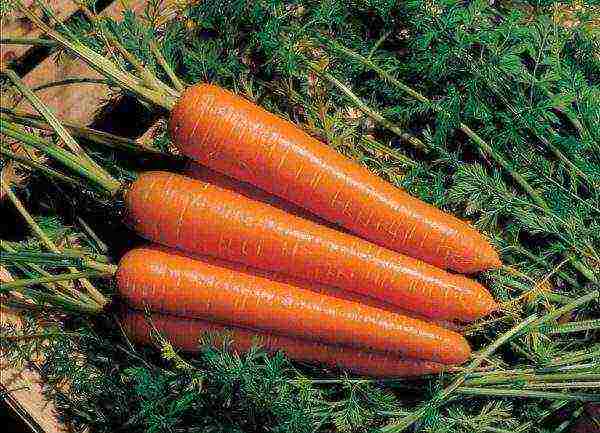 Carrot Flaccoro variety
Carrot Flaccoro variety
Deserves attention, productive (from 8 kg / m²), with large (200 g), long (28 cm) rootscontaining a high percentage of carotene.
Sweet carrot varieties
The best root vegetables for baby food are sweet. They are more beneficial due to the high percentage of carotene. Among the late varieties that are sweet and can be stored for a long time, one can distinguish:
- Karotan;
- Darling;
- Emperor.
Karotan
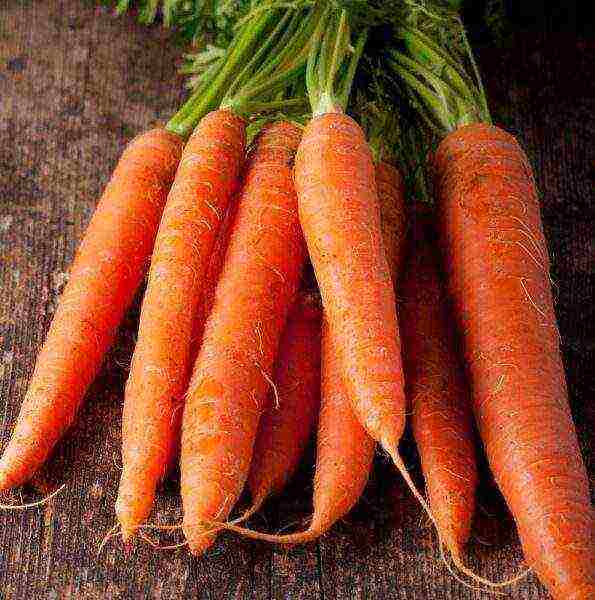 Sweet carrots Karotan
Sweet carrots Karotan
World renowned carrots are rich in carotene. It is recommended to be used as a raw material for processing. Carotan is stored for a long time, its characteristics: deep orange color, cross-sectional diameter from 5 cm, length of root crops not less than 25 cm.
Darling
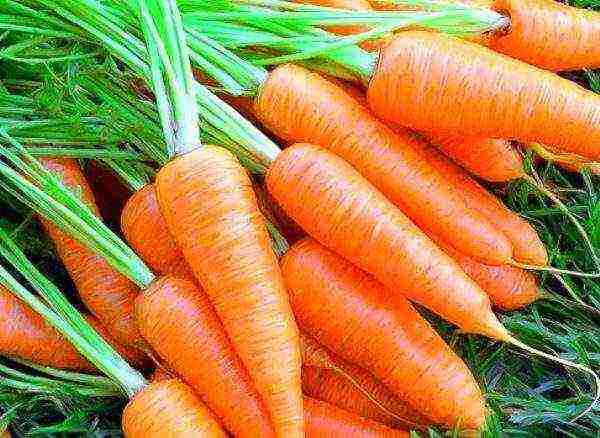 Carrot variety Favorite
Carrot variety Favorite
Sweet, perfect cylindrical shape. Ripe roots have an average length (15 cm) and weight (160 g), and are well stored. When sown in autumn, Favorite gives an early harvest in years rich in precipitation, does not crack.
Early
Already in June, you can feast on fresh fruits if you plant an early variety in early spring with a growing season of 80 to 90 days. You can pick up a fruitful variety that will feed the family in the summer and will be well stored in the cellar..
Touchon
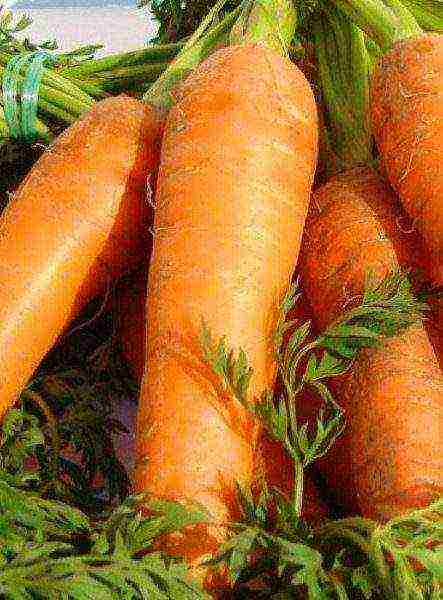 Early carrots Tushon
Early carrots Tushon
These are cylindrical, thin root crops, average length 15 cm, weight - 100 g. Productivity - 5 kg / m²... For winter consumption, it can be sown in mid-June. To obtain early root crops, autumn sowing (October, November) is recommended.
Artek
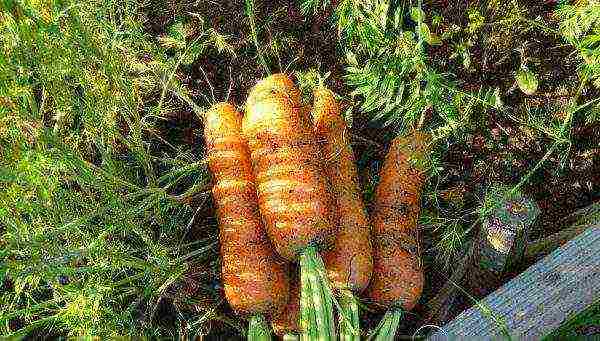 Carrot grade Artek
Carrot grade Artek
An easy-care early variety. Artek can be stored well in the cellar. Burgundy-orange root vegetables with an average weight of 150 g and a length of 15 cm do not rot, juicy, tasty... For summer consumption, the fruits are ready in 1.5 months.
Fun F1
 Carrot variety Zabava F1
Carrot variety Zabava F1
An early hybrid, ideal for summer beam production. Can be grown for winter consumption. Root vegetables are bright orange, not large from 50 gare of medium length.
Large
Large carrots are good for making healthy juice and Korean dishes. Here are the varieties to look out for next season:
- Canada F1;
- Nandrin F1;
- Russian size.
Canada F1
 Large-fruited carrots Canada F1
Large-fruited carrots Canada F1
Unpretentious medium-late hybrid, gives good yields on heavy soil. Fruit weight from 130 to 500 g, length 20 cm, cross-section up to 5 cm... The plant is characterized by a sweet, juicy orange pulp.
Russian size
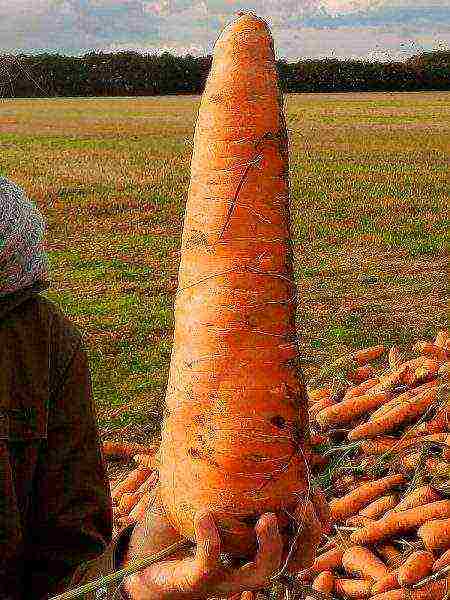 Carrot grade Russian size
Carrot grade Russian size
A variety that yields root crops weighing up to 1 kg on light, fertile soils. Norm for carrots - large diameter (6 cm)... The length is also not small - from 25 to 30 cm.
Nandrin F1
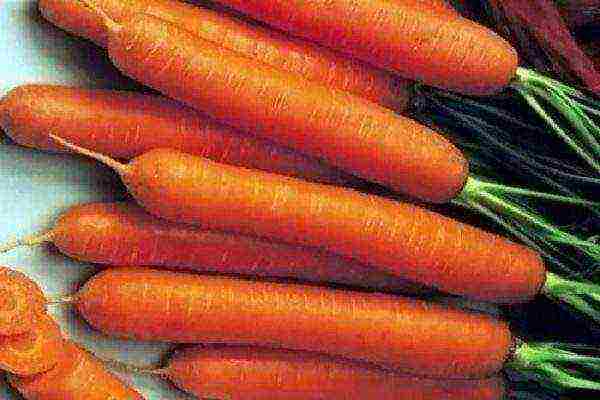 Carrot grade Nandrin F1
Carrot grade Nandrin F1
A popular hybrid from Dutch breeders among farmers. Short growing season up to 100 days. Carrots with a small core, cylindrical shape, do not crack. The average weight of Nandrin F1 is 150 g. Root crops grow up to 20 cm long.
How to choose carrots for storage
For those new to the gardening business, choosing carrots suitable for long-term storage is a challenge. In a huge selection, it is easy to get lost and take the first packet with a beautiful picture. This is not worth doing. Here is a list of characteristics that will help you choose the right variety for storage:
- growing season from 115 days and more;
- does not crack;
- not susceptible to disease;
- suitable for growing in any climate, on any soil;
- does not arrow.
Conclusion
Long-term storage is not only the right carrot variety. This is the optimal planting time, proper care and the choice of the optimal way of storing root crops.
Any summer resident will have a bed with carrots in the summer. It is interesting that in some in the fall the cellar is littered with orange root crops, while in others there is nothing to lower there. A fiasco also happens among experienced gardeners. There are many reasons for this, one of them is bad seeds, but more often it is the lack of time for thinning.
And with carrots like this: did not have time to thin out the seedlings in time and that's it.In the fall, instead of orange beauties with powerful tops, there are tiny carrots, which you really don't want to eat. For those who are too lazy or have no time to do thinning, they sell carrot seeds in granules, in particular, how to plant it, now let's try to figure it out.
Seed selection
First, you need to get quality seeds before sowing carrots in granules in the spring. How can you avoid making a mistake with your choice? The bags contain useful information - the expiration date of the seeds. It is very good if, in addition to the expiration date, there is a packaging date. The germination capacity of carrot seeds lasts no more than 2 years. If they are old, it does not matter how you plant carrots in granules correctly or incorrectly. They simply will not rise up in you.
The topic of carrots in helium granules is very popular on the Internet, everyone wants to fill up the harvest with a minimum of costs. The quality of carrot seeds in granules from the "Lazy Bed" series is especially often discussed. Some scold the seeds for poor germination, others praise them for a stable harvest. Apparently, the problem is that not everyone knows how to plant granulated carrots.
For those who prefer to plant carrots with seeds, but want to save time on thinning, the idea of making granules with seeds with their own hands will come in handy. To implement the idea, you will need fresh seeds of the carrot variety you like, a roll of toilet paper and some free time. Watch a video on how to make carrots in granules with your own hands, you need to plant them in the same way as store seeds:
Landing dates
Carrots are a cold-resistant culture, temporary spring cold snaps do not affect its germination. In open ground, you can plant carrots in granules as soon as the soil warms up to 8 ° C. In the middle lane and beyond the Urals, this is mid - end of April. The snow has already melted by this time, the soil is quite wet, and the daytime temperature is about 15 ° C.
In May, you can continue to plant carrots in granules. If you need carrots for winter storage, choose varieties:
- late (110–130);
- medium (98-115);
- medium late (90–114).
For them, the optimal time for planting will be May. By October, the roots will be ready for harvest. Harvested in the fall, washed and chilled for several days, they will be perfectly stored throughout the winter. The best varieties for bookmarking for the winter:
- Shantane;
- Forto;
- Autumn Queen;
- Samson.
For summer consumption, carrots can be sown before winter. Planting time October - middle or end of the month. The exact timeframe depends on the specific region. Before winter, you can plant varieties of any seed ripening period, but if you want to pull fresh carrots in June, sow early ones. For example, Tushon carrots are ready to eat 60 days after germination. Later we will tell you how to properly plant carrots in granules before winter.
Garden bed preparation
A properly prepared ridge is half the battle. Saving time on preparation is not worth it. Choose a place in the fall. Where carrots grew in summer, do not do the ridge. When the garden is small, it is difficult to adhere to the rules of crop rotation.
In this case, green manure seeds (mustard, rye) help. Sow them immediately after harvest. Mustard stalks can be buried in the ground in the fall, it grows back quickly, and the rye can be left until spring. The best predecessors of carrots are considered:
- cucumbers;
- cabbage;
- greens;
- radish;
- zucchini.
For the best germination of granular carrots, the soil must be constantly moist, therefore, the location of the garden bed relative to the wind rose is important. Draft dries the topsoil, impairs germination. A comfortable place behind the wind, but in the sun. Usually this is the southern or southwestern part of the garden.
Advice! Buy early-ripening radish seeds, plant it as a beacon crop in the same furrow with carrots. The radish will rise faster and will highlight the planted rows. The spaces between the rows of radishes can be loosened to get rid of weeds.
Carry out basic soil preparation in the fall:
- remove the remnants of plant debris;
- add well-rotted humus;
- evenly scatter superphosphate and potassium nitrate over the entire area of the ridge (25 g and 10-15 g, respectively);
- dig up a bed on a shovel bayonet;
- burrow through.
It remains only in the spring to loosen the soil and at the same time add urea or ammonium nitrate to it.
Landing
Moist soil is the main condition for good germination when planting carrots with granular seeds. Water abundantly if the snow has melted a long time ago and the soil is already dry. It is better to do this 5 days before sowing the granules. The soil is well saturated with moisture, settles, it will be easier to sow granules into it.
Seeds are sown in granules at intervals of 5 cm, this distance is sufficient for the normal development of the root crop. With such a planting, thinning is not required even at 100% germination.
You can sow carrot seeds in granules in grooves 2.5–3 cm deep or in separate depressions. Leave the interval between rows at least 20 cm for late varieties, 15 cm for early carrots.
Advice! For the prevention of carrot flies, the grooves can be powdered with ash and hot red pepper.
The grooves can be made both along and across the ridge. It is important that the surface of the ridge is horizontal. Otherwise, water will drain during irrigation, this threatens with leaching of seeds, uneven soil moisture. It is better to make grooves with the edge of a board 25-30 mm thick or with a strip, holes - with your finger. We recommend watching a video on how to properly plant carrots in granules using a simple device:
Thoroughly spill the grooves with water from a watering can; any biological product can be added to the water. When the moisture is absorbed, carefully spread the granules in 5 cm increments. Fill the furrows with sifted humus (coconut fiber, vermicompost), carefully water the ridge.
Advice! Seeds sprinkled with humus, vermicompost or coconut fiber sprout much faster than granules sprinkled with ordinary earth.
At the end, sprinkle the entire surface of the bed with a thin layer of humus and no longer water it, so that a crust does not form on the surface. The seeds should end up at a depth of no more than 2.5 cm.
Features of sowing pellets in autumn
You can immediately list three real benefits of sowing carrots in the fall in granules:
- in the spring, you do not need to do watering, the granules will get wet under the influence of melt water;
- the carrot harvest will ripen much earlier than with early spring sowing;
- in the spring there will be time savings on planting and watering carrots, it can be spent on other vegetable crops.
Sow carrots according to the weather. The main condition is a low average daily temperature of 0 to 2 ° C. Prepare the bed when the weather is warm, also outline the grooves in advance. After the onset of cold weather, it remains to decompose the granules and sprinkle them with earth.
When sowing early varieties of carrots for summer needs in the fall, the interval from 5 cm can be reduced to 3 cm. In summer, bunch-type carrots can be torn for small food, the remaining root crops will have enough space for development.
Watering and weeding
Abundant watering is needed in the first 2-3 weeks after sowing the granules. At first, moisture is needed to swell the granule and soften it, then to feed the carrot seeds. They sprout because of the essential oils that cover the shell for a long time: 2 weeks, no less.
After the appearance of green panicles on the ridge, the soil must be kept in a moderately moist state:
- lack of moisture makes the root crop tough;
- excess moisture has a negative effect on storage, root crops rot.
Watering with water must be alternated with dry watering - shallow loosening of the space between the rows. Loosening prevents the formation of a soil crust, helps to get rid of weeds. In August, slightly spud the carrots: cover the protruding butts with earth.
If the carrots have not sprouted
If the experiment with planting carrots with granules failed, it is already the beginning of June, and seedlings have not appeared or there are very few of them, the situation can be corrected. A video will help on how to plant carrots in June if the granulated seeds did not sprout:
For June sowing, buy fresh seeds without a shell.By this time, you can learn about germinating seeds from neighbors. Buy from the same company as theirs. In June, it is worth planting varieties of medium or late ripening. Carrots, planted with seeds in early June, will have time to gain the desired weight and size by the beginning of the first frost.
Conclusion
It is not difficult to grow large and juicy carrots from granules. For a good harvest, it is enough to buy high-quality seeds and spend time preparing the soil. Do not regret a sunny place in the garden for an orange root crop. And of course, water the carrot ridge with a watering can for three weeks, until vigorous green panicles stick out on it.
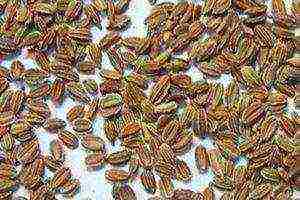
Carrots are the most popular vegetable in our gardens. Anyone who has a plot of land to plant vegetables buys 2 to 20 packs of carrot seeds.
The popularity of this vegetable is understandable. Carrots are present in almost every dish, many preparations for the winter are made with it, very useful juices are obtained from it. It contains a large amount of carotene, provitamin A, therefore, it improves vision and skin condition, and affects human growth. (Read more about the vitamins in carrots here.) Many carrots are grown to feed animals and birds. Growing carrots is very simple and keeps well.
What are the seeds
On sale you can find:
- Common seeds in bulk. Sold in packs, color and white. White bags are cheaper. If the same variety is in the color and white bag, choose the white bag to pay for seeds, not pictures.
The number of seeds in a bag is measured in grams. A pack usually contains 2 grams of carrot seeds. If it's an expensive, hybrid variety, it could be 1 gram, or even 0.5 gram. Imported hybrid seeds can be dyed, so when buying seeds look at weight first, then price.The price may be lower, because there are several times less seeds in the package.
- Granular seeds... Carrots of any kind, if planted very densely, will be small. Such carrots are called "mouse tails". Sowing simple seeds at once is rarely possible for many. Therefore, seeds are sold in granules.
Granules are red or green in color, there is one seed inside. The pellet itself is composed of nutrients and lime. In packs, granules are poured in pieces. Look on the packet to see how many pellets there are. The quantity can be from 150 to 500 pieces, therefore the price is different.
Planting granules requires more moisture in the ground, since the granule must dissolve first, and then the moisture will penetrate to the seed. Because of this, granulated seeds take longer to germinate, and their germination rate is worse. But they definitely do not need to be thinned out and the carrots are always large. For the price they come out much more expensive than simple seeds.
- Seeds on a tape. You no longer need to glue seeds on toilet paper in advance in winter. Carrot seeds are now sold on tape.
When planting, they simply shed a groove with water, lay out a tape with seeds glued to it, sprinkle with insecticide, apply a little fertilizer and cover with earth. It couldn't be easier. For those who sow few carrots, this is a good way, because there are few seeds on the belt, but they are expensive. The ribbons are generally 8-10 m long.
When buying seeds on tape, pay attention to the footage.
Take a note: carrots are better stored if the top is cut off before laying for the winter so that there is no green stump left. Then it will not rot during storage.
Most popular varieties
The following varieties of carrots are distinguished from the popular ones:
- Early and mid-early varieties of carrots: Amsterdam, Touchon, Nantes-4, Marlinka, Children's sweetness. Early varieties of carrots are distinguished by the tenderness and juiciness of the root crop. They are mainly used fresh and made into juices.
Root crops of early varieties are thin, long, well forming summer bundle products, which are in demand on the market. The disadvantage of such varieties is their short storage.Because of their elegance, tenderness and juiciness, they are stored only until the new year, and then wither or rot. Therefore, sowing such varieties in large quantities is not recommended.
- Mid-season carrot varieties:vitamin, Losinoostrovskaya -13, Moscow winter, NIIOH-336, Red giant, Flakke, Forto. Mid-season crops are the most popular, because the root crops are large (Losinoostrovskaya-13), quite juicy (Vitaminnaya), very sweet (NIIOH-336), perfectly stored (Moscow winter), have a beautiful presentation (Flakke).
One of the best mid-season varieties is Samson - F1. Very large, even root vegetables, excellent taste, excellent storage. True, the seeds are Dutch and therefore expensive, usually 0.5-1 grams in a pack. There are fakes, so you need to buy only from trusted manufacturers.
- Late ripening carrot varieties:Autumn Queen, Autumn King, Moe, Shantane. Late ripening - large root crops, dense, harsh, not the most juicy.
It is difficult to nibble on carrots of this kind just like that, but they keep well and are very sweet. Therefore, these varieties are very popular in villages where livestock and poultry are fed with carrots. Root crops in their shape are thicker and wider than early and mid-season varieties, they suffer less from carrot fly larvae. In stores in winter, late-ripening carrots are most often sold.
Take a note: before winter, you can sow any varieties of carrots - they sprout the same way. The main thing is that the soil for podzimnogo sowing should be loose. As soon as the snow melted and a dry crust appeared on the surface of the bed, loosen it. Do not water until friendly shoots appear.
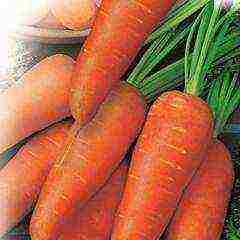
Shantane carrots
What seeds should I buy? It is best to plant a pack of early varieties, 2 packs of mid-ripening, and 1 pack of late-ripening, in this ratio. Sowing is still better in spring, when the earth warms up and is loose. Carrots are not afraid of frost, but in cold, damp ground, the seeds can rot and not sprout at all. Which often happens, and then it is re-sown.
Out of habit, people buy those seeds that everyone knows, these are mainly varieties: Nantes, Queen of Autumn and Chantane. Each variety is good, but at least one new variety needs to be sown every spring, so as not to take risks and perhaps find an even better, productive variety.
Reviews
Carrot Samson F-1
This year I tried to plant the Samson F-1 carrot variety. I was satisfied. The carrots were dug with a shovel because they were very large. Root crops are smooth, long and tasty. The yield is very high. There were practically no cracked fruits.
Irina T., pos. Iglino, RB
Last year I planted an early variety - Marlinka. I liked that the roots are large, juicy and tasty. There is almost no core in them. This year I will definitely plant again.
Natalia K., Ufa
I really liked the variety of carrots with the unusual name NIIOH336. He sowed all sorts of sorts, this one seemed to me the sweetest. It is not the largest, but it was kept perfectly all winter, remaining juicy and tasty. I sowed it before winter, in the spring it sprouted perfectly, and there were no ugly root crops.
Sergey V., p. Okhlebinino, RB
The video will help you navigate the variety of carrot varieties:
Rate the article:
(0 votes, average: 0 out of 5)

